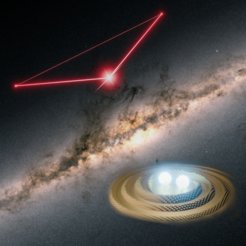ESA gives go-ahead for flagship gravitational-wave observatory in space
LISA, the Laser Interferometer Space Antenna, has passed a major review with flying colours: the entire concept – from the definition of the overall mission and operations to the space hardware to be built – stood up to the intense scrutiny of ESA´s reviewers. Now the space agency´s Science Programme Committee (SPC) has confirmed that LISA is sufficiently mature and that mission development can proceed as planned. LISA should go into orbit in the mid-2030s.

“LISA is such an incredible and unique mission; there is such a variety of sources that can be probed with it,” says Valeriya Korol, postdoctoral fellow at the Max Planck Institute for Astrophysics (MPA) and co-chair of the LISA Astrophysics working group. “We will be able to look at binaries of stellar remnants within our own Galaxy, in-spiralling compact objects onto massive black holes at larger distances and all the way to mergers between nascent massive black holes in the early Universe.”
LISA will detect gravitational radiation in the yet unexplored window between 0.1 mHz and 1 Hz, waves that cannot be detected by ground-based detectors. Waves in this frequency range are created in the collision and merger of two massive black holes, a million or more times heavier than our Sun, lurking at the centres of distant, still forming galaxies. LISA will be sensitive to these mergers across the Universe's history, directly probing the yet unknown origin and growth of massive black holes. Unique to LISA is the detection of gravitational waves from stellar black holes swirling around massive ones in galactic nuclei, to probe the geometry of space-time and test gravity in its foundations. LISA will also detect a large number of binary and multiple compact objects in our Milky Way galaxy to tell us about stellar binary evolution, and "see" the Galaxy beyond the Galactic Centre, including many objects invisible to all other astronomical instruments.
Numerous scientists at MPA are already preparing for science with LISA. The primary focus here is on predicting the characteristics of the signals that LISA will detect from galactic binaries, which include white dwarfs, neutron stars, and black holes. Astronomers already know that these objects exist in our Milky Way, and they will probably outnumber other types of sources LISA will encounter. This effort is crucial for developing LISA data analysis methods, interpreting data accurately, and devising strategies for electromagnetic follow-up observations.
“We have already seen gravitational wave signals from ground-based observatories – going into space opens up a whole new window,” emphasizes Selma de Mink, director of the stellar department at MPA. “This will be a totally new way to learn about black holes in our own galaxy and to better understand the stellar sources that are generating gravitational waves.”
The LISA instrument is a first of its kind space borne gravitational wave observatory. It will consist of three spacecraft in a triangular configuration with 2.5-million-kilometre arms, moving in an Earth-like orbit around the Sun. Gravitational waves from sources throughout the Universe will produce slight oscillations in the arm lengths (smaller than the diameter of an atom). LISA will capture these motions and thus measure the gravitational waves by using laser links to monitor the displacements of test masses free-falling inside the spacecraft.
“With the Adoption decision, LISA is now firmly established in ESA’s programme of missions. We are looking forward to realising LISA in a close collaboration of ESA, NASA, ESA member states and the wider LISA Consortium” says Karsten Danzmann, Lead of the LISA Consortium, Max Planck Institute for Gravitational Physics and Leibniz University Hannover. “This trailblazing mission will take us to the next level in a really exciting area of space science and keep European scientists at the forefront of gravitational wave research,” adds ESA Director of Science Carole Mundell.












